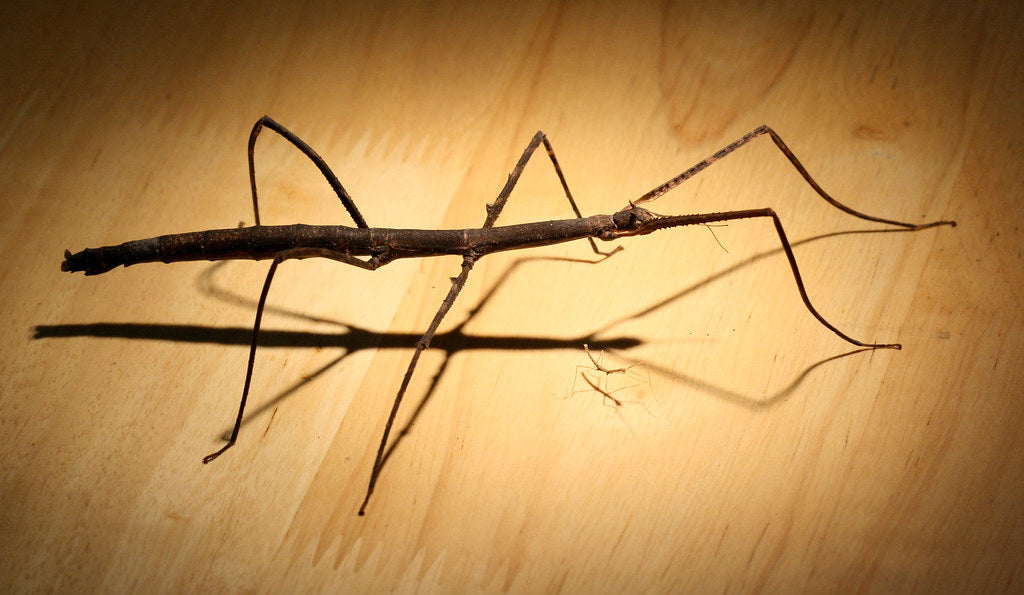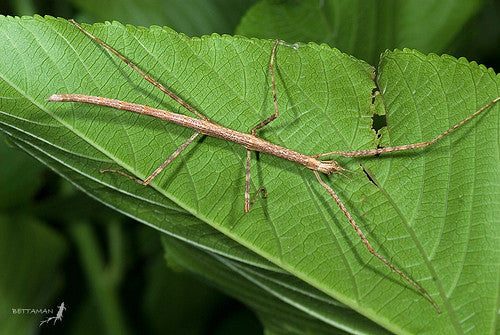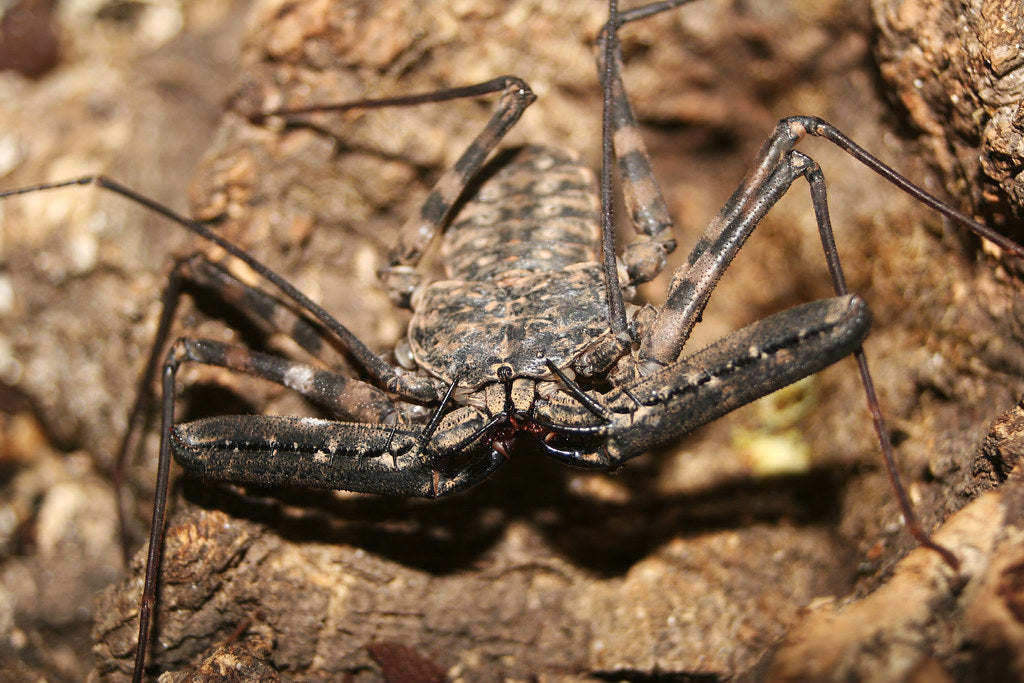The Annam walking stick (Medauroidea extradentata) is a medium-sized, nocturnal, herbivorous invertebrate native to Vietnam. It is also known as the “thorny stick insect”.
Annam walking sticks grow 3-4.5” long, with males being significantly smaller and more slender than females. Like all stick insects, they are designed for optimum camouflage, and this species resembles a twig as adults. The body is long and slender, with long and slender legs to match, and females have two horns on their head. When they are young, they are green or brown and green, but as they age, they turn uniform brown in color.
Annam walking sticks make popular pets due to their docile disposition and easy care. Total lifespan is short, around 5-7 months.
How much space do Annam walking sticks need?
The general rule with housing stick insects is that the enclosure length and width should be at least twice that of the stick insect’s expected adult length, and the height should be at least three times expected adult length. A good starting point is 8”W x 12”H. The enclosure should have a mesh top for your pet to hang from for molting, and it should be well ventilated. Full-mesh enclosures work very well in climates that are not particularly dry.
Annam stick insects can be housed in groups just fine. The important thing to remember for housing groups is that they will need more space, particularly horizontally.
Do Annam walking sticks need special lighting?
As long as the stick insect’s enclosure is in a room that receives ~12 hours/day of artificial or bright natural light, then additional lighting equipment is unlikely to be necessary. However, if it is being kept in a dark room then ~6500K fluorescent or LED illumination is helpful.
Do not place your stick insect’s enclosure in front of a window, as the sunlight can overheat the enclosure and kill your pet!
What basking temperatures do Annam walking sticks need?
Annam walking sticks usually do well anywhere between 68°F and 86°F, so they can be kept at room temperature. Keep track of the temperatures inside your enclosure with a digital thermometer like the Zoo Med Digital Thermometer & Humidity Gauge, with the probe placed in the middle.
This wide range of tolerance generally means that Annam walking sticks can be kept comfortably at room temperature without supplementary heating.
What humidity levels do Annam walking sticks need?
Humidity is very important for successfully keeping stick insects as pets, as it helps ensure successful molting and general wellbeing. That being said, Annam walking sticks aren’t terribly picky about their ambient humidity.
It’s good practice to lightly mist your pet’s enclosure with a spray bottle every evening to increase humidity and provide water for your pet to drink. Tap water is okay to use, but only if you dechlorinate it first. If this is not possible, it’s best to use distilled water.
What substrate is good for Annam walking sticks?
Substrate is important to a stick insect setup because it helps maintain healthy humidity levels. It’s best not to go bioactive, as your stick insect will eat the plants. Here are some better substrate options:
- Zoo Med Creatures Eco Soil
- Zoo Med Creature Soil
- Zoo Med ReptiBark
- Eco Earth Plantation Soil
- Exo Terra Forest Bark
- Zilla Bark Blend
You don’t need very much substrate. Depending on the size of the enclosure, 1-2” should be plenty.
To keep your stick insect’s enclosure clean, replace the substrate weekly and completely rinse out the enclosure and decor with hot water. Don’t use soap or disinfectants, as the residue may harm your pet!
What décor can you use in an Annam walking stick terrarium?
Annam walking sticks like having things to climb and hide amongst in their enclosure. This encourages natural behaviors, which makes them more fun to watch, and decreases stress, which in turn increases lifespan. Here are some ideas:
Climbing objects should be arranged at a variety of angles to give your pet options. Hot glue is excellent for adhering climbing objects and artificial foliage to terrarium walls.
Make sure to leave an open space at the top of the enclosure twice the height of your pet for molting.
What do Annam walking sticks eat?
Annam walking sticks are herbivorous, which means that they eat plants. They eat leaves from the following plants:
- Blackberry (older leaves only, no new leaves)
- Oak
- Hawthorn
- Rose
- Hazel
Food should be available every other day — it’s not a good idea to starve your stick insect! It’s best to offer a branch of leaves, placed in a weighted vase of water to keep the leaves fresh for as long as possible.
Oak leaves freeze well for winter, and blackberry leaves usually stay available throughout winter. If you are having difficulty sourcing appropriate leaves for your stick insect to eat, (organic) romaine lettuce can be used in a pinch. However, it is best practice to provide a variety of different leaves for balanced nutrition.
Never use leaves from garden centers or florists, as these are likely to be treated with insecticides that will kill your pet! It is also best to avoid collecting leaves near roads, as they are contaminated with vehicle exhaust.
Do Annam walking sticks like to be handled?
Generally speaking, pet invertebrates don’t like to be handled very much, but Annam walking sticks generally tolerate it alright. To handle your pet stick insect, place your hand under its front legs and use your other hand to scoop it up from behind. Be very gentle and let the stick insect come off the branch onto your hand of its own volition — otherwise can get injured!
Keep in mind that Annam walking sticks are known to play dead when startled. Be patient, and your pet will “come back to life” after a few minutes.
*This care sheet contains only very basic information. Although it’s a good introduction, please do further research with high-quality sources to obtain additional information on caring for this species.
"Medauroidea extradentata (mother & son)" by gertschi911 is licensed under CC BY-NC-SA 2.0




Leave a comment
This site is protected by hCaptcha and the hCaptcha Privacy Policy and Terms of Service apply.